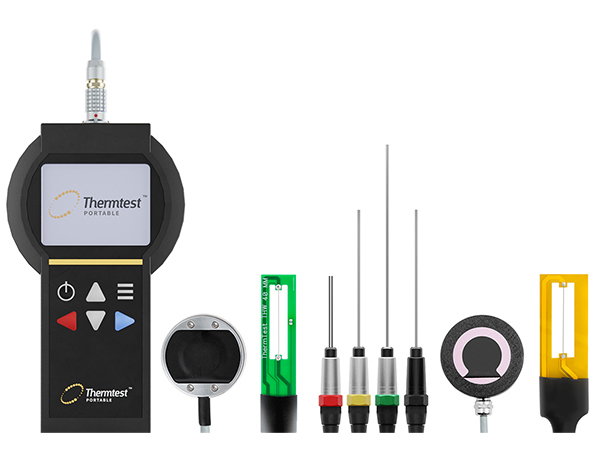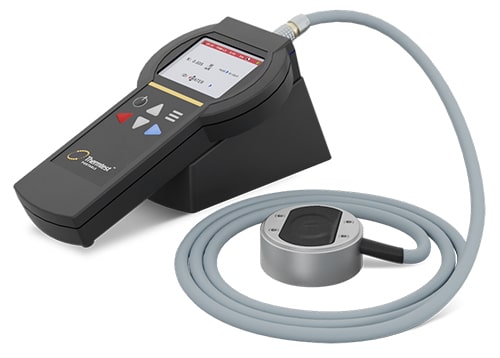The Measurement Platform-2 (MP-2) is an advanced meter with unique selection of transient thermal conductivity sensors for a variety of applications, with a focus on primary measurements. The transient thermal conductivity sensors share similar principles of operation.
The sensor wire is heated using a constant current source (q) and the temperature rise is recorded by monitoring the change in electrical resistance of the wire (THW and TPS) or by resistance temperature detector device (TLS). For samples of high thermal conductivity, resistance increases more slowly over time; for samples of low thermal conductivity, resistance increases more quickly over time.

Picture 1. Thermtest MP-2 Thermal Conductivity Meter
Thermal conductivity MP-2 users benefit from the convenience and accuracy gained when using primary testing methods. The MP-2 controller auto-detects the connected sensor and loads corresponding testing parameters. Measurements are easily performed with the smart on-board software and transferred to computer with an included Windows utility program.

Picture 2. Thermtest TPS 4 sensor for use with the MP-2 portable meter.
The Transient Plane Source (TPS 4) single-sided (asymmetric) sensor is one of the many sensors offered with the Thermtest Portable Measurement Platform (MP-2). This sensor offers simple yet accurate measurements of low density and low thermal conductivity materials from 0.03 to 5 W/m·K via the transient plane source method.
The compact sensor can be placed underneath smaller samples or on top of larger samples. In either case, a 1kg weight should be applied to ensure appropriate contact between the sensor and the sample. With the surface sensor there are three different power settings that correspond with the thermal conductivity of the test sample to allow for optimal temperature increase.
The TPS 4 follows the theory of traditional transient plane source (TPS). The TPS 4 has a 5% accuracy and a 2% reproducibility of measurement, making it a highly accurate and precise instrument for measuring the thermal conductivity of polymers, ceramics, and composites.
Ceramics are a type of hard material characterized by their high melting point and resistance to both heat and corrosion. Three commonly used ceramics are Macor, Mullite and Pyroceram 9606. Macor is a type of glass-ceramic known for its ability to be easily machined into any shape, allowing it to be used in a wide variety of applications.
Mullite is a natural mineral, though it is much more commonly produced as a synthetic by various melting and firing processes. Like glass-ceramics, ceramics made with mullite have a low thermal conductivity and are stable at temperatures over 1000°C. Pyroceram 9606 is an opaque glass material with high heat tolerance and low thermal expansion. It is also a certified reference material.
For this experiment, samples were placed on top of the surface sensor then a 1kg weight was placed on top of the sample.
Table 1: Results of three different samples measured with the TPS 4 sensor on the MP-2 at room temperature.
Reference values via ISO 27002:2